- Joined
- Feb 2, 2011
- Messages
- 2,093
NEW RELEASES FOR JUNE 2024
THE EIGHTEENTH CENTURY COLLECTION
THE AMERICAN WAR OF INDEPENDENCE 1775 – 1783
THE BATTLE OF COWPENS, JANUARY 17[SUP]th[/SUP], 1781.
THE 7[SUP]th[/SUP] REGIMENT OF FOOT (ROYAL FUSILIERS.)
The Battle of Cowpens was an engagement during the American Revolutionary War fought on January 17[SUP]th[/SUP] 1781, near the town of Cowpens, South Carolina, between American forces under Brigadier General Daniel Morgan, and British forces under Lieutenant Colonel Banastre Tarleton, as part of the campaign in the Carolinas.
The battle was a turning point in the American reconquest of South Carolina from the British.
Tarleton’s force of 1,000 British troops were set against 2,000 troops under Morgan. Morgan’s forces suffered casualties of only 25 killed and 124 wounded. Tarleton’s force was almost completely eliminated with almost 30% casualties and 55% of his force captured or missing, with Tarleton himself and only about 200 British troops escaping.
Morgan’s forces conducted a double envelopment of the British forces, the only double envelopment of the war.
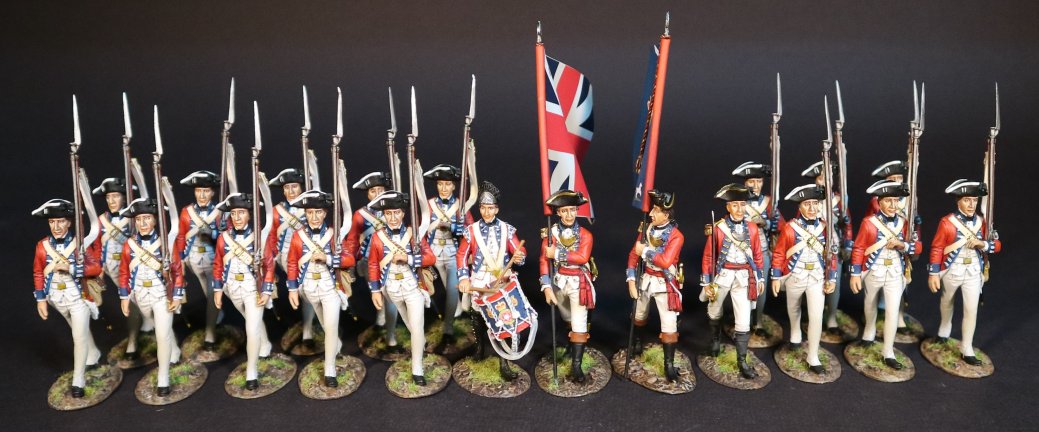
The Royal Fusiliers (city of London Regiment) was a line infantry regiment of the British Army which has been in continuous existence for 283 years. It was known as the 7[SUP]th[/SUP] Regiment of Foot until the Childers Reforms in 1881.
In 1747 the regiment was known as the Royal English Fuziliers and was given the precedence of 7[SUP]th[/SUP] in the Infantry of the Line. On 1[SUP]st[/SUP] July 1751 it was redesignated as the 7[SUP]th[/SUP] Regiment of Foot (Royal Fusiliers).
When county titles were added in August 1782 the subtitle (Derbyshire) was added, but this was never used and was later given to a different regiment.
The Royal Fusiliers were sent to Canada in April 1773. The regiment was broken up into detachments that served at Montreal, Quebec, Fort Chambly and Fort St. Johns. In the face of the American invasion of Canada in 1775/76, the 80 man garrison of Fort Chambly attempted to resist a 400 man Rebel force but ultimately had to surrender, losing its regimental colors as a result. The bulk of the regiment was captured when St. John’s fell.
A 70 man detachment under the command of Captain Humphrey Owens assisted with the Battle of Quebec in December 1775.
The men taken prisoner during the defense of Canada were exchanged in British held New York city in December 1776. Here the regiment was rebuilt and garrisoned New York and New Jersey. In October 1777, the 7[SUP]th[/SUP] participated in the successful assaults on Fort Clinton and Fort Montgomery and the destruction of enemy stores at Continental Village. In late November, 1777 the regiment reinforced the garrison of Philadelphia. During the British evacuation back to New York city, the regiment participated in a diversionary raid in the days leading up to the Battle of Monmouth in June 1778.
In April 1780, the Royal Fusiliers took part in the capture of Charleston. Once Charleston fell, the regiment helped garrison the city. Three companies were sent to Ninety-Six to assist with the training of Loyalist militia companies. An 80 man detachment was also sent to Camden, South Carolina to help build that town’s defenses. The detachments were recalled to Charleston for refitting in late August 1780.
The 7[SUP]th[/SUP], mounted on horses, along with the two regiments of Loyalist militia, cleared the region north of Georgetown, South Carolina of partisans while en route. The Royal Fusiliers turned the horses over to Lieutenant Colonel Banastre Tarleton’s British Legion upon uniting with Cornwallis in late September and then served as the Army’s rearguard.
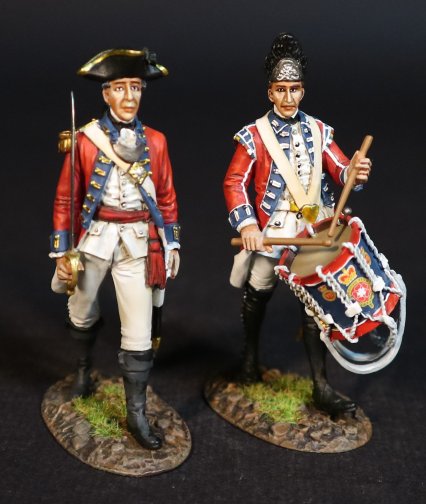
CW7FL-01
THE AMERICAN WAR OF INDEPENDENCE 1775-1783,
THE BATTLE OF COWPENS, JANUARY 17[SUP]th[/SUP] 1781,
7[SUP]th[/SUP] REGIMENT OF FOOT (ROYAL FUSILIERS)
OFFICER AND DRUMMER
THE BRITISH LEGION
The British Legion was a British provincial regiment established during the American Revolutionary War, composed of British loyalist American infantry and dragoons. It was known as Tarleton’s Raiders after the British officer who led most of its day to day activities, Lieutenant Colonel Banastre Tarleton, and the green uniform coats. It was an unit the size of a regiment consisting of infantry, cavalry, and artillery, and able to operate independently.
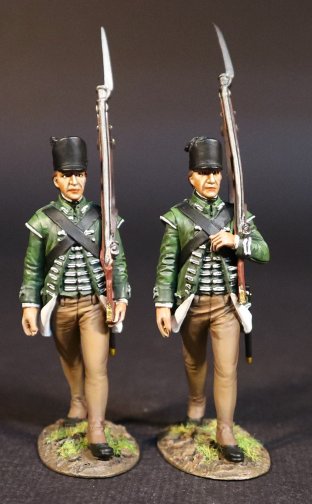
CWBL-08
THE AMERICAN WAR OF INDEPENDENCE 1775 – 1783
THE BATTLE OF COWPENS, JANUARY 17[SUP]th[/SUP], 1781.
THE BRITISH LEGION – “TARLETON’S RAIDERS”,
BRITISH LEGION INFANTRY
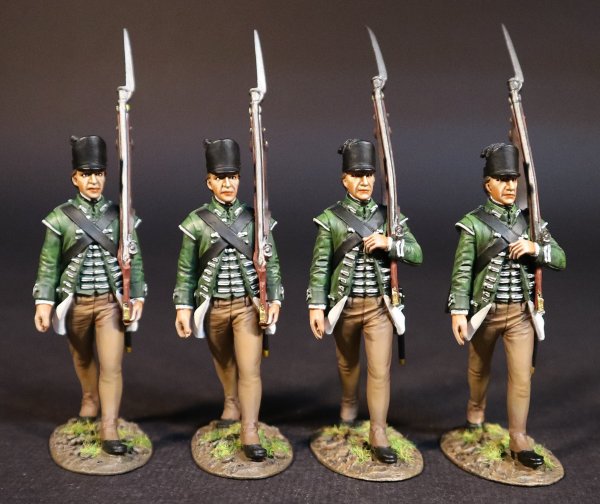
CWBL-08N
THE AMERICAN WAR OF INDEPENDENCE 1775 – 1783
THE BATTLE OF COWPENS, JANUARY 17[SUP]th[/SUP], 1781.
THE BRITISH LEGION – “TARLETON’S RAIDERS”,
BRITISH LEGION INFANTRY
THE QUEEN’S RANGERS (1[SUP]st[/SUP] AMERICAN REGIMENT) 1778-1783
SIMCOE’S RANGERS
The Queen’s Rangers came into being when Robert Rogers was authorized to raise a “Corps of Provincials” on August 16[SUP]th[/SUP] 1776. Recruited originally from Loyalists in New York and Connecticut, its men were farmers and city dwellers with little military experience.
They were a Loyalist military unit and were named for Queen Charlotte, consort of George III. The Queen’s Rangers served as a light corps in the tradition of British Rangers during the war, operating on the flanks and in advance of Crown forces, manning outposts, conducting patrols, and carrying out reconnaissance and raiding operations.
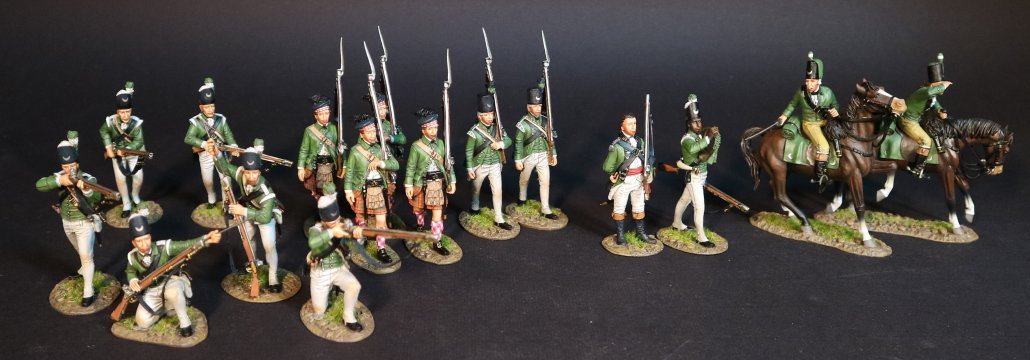
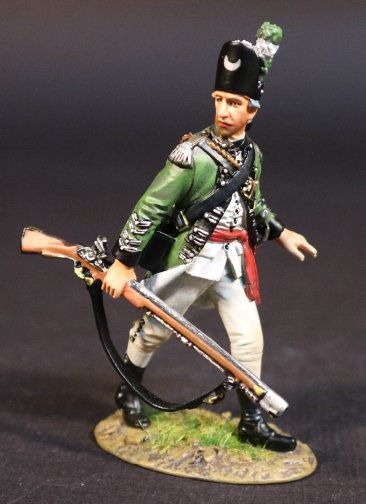
SQR-14
THE AMERICAN WAR OF INDEPENDENCE 1775 – 1783
THE BRITISH ARMY,
THE QUEEN’S RANGERS 1778-1783,
SIMCOE’S RANGERS,
LIGHT INFANTRY OFFICER
Simcoe had advanced ideas regarding training and discipline. He advocated constant vigilance, physical activity, and endurance of fatigue. There was constant instruction in marksmanship, the use of the bayonet, open formations, and the use of ambuscades. Units were trained to seldom return by their outgoing route. Officers were selected on their ability to perform such duties, and promotions when they occurred were from within the corps.
Regularity of messing and cleanliness were stressed, and officers were held responsible for the health of their men.
Written orders were avoided when possible, officers met after parade and received their orders verbally.
After the war, the Rangers were removed to the British colony of Nova Scotia and disbanded.
THE SEVEN YEARS WAR
THE THIRD CARNATIC WAR 1756-1763
THE BATTLE OF WANDEWASH, 22[SUP]nd[/SUP] JANUARY 1760
THE BRITISH ARMY
The Battle of Wandewash was a confrontation between the French under the command of The Comte de Lally, and the British Sir Eyre Coote. It was the decisive battle in the Anglo French struggle in southern India during the Seven Years War.
Lally, cut off from sea support by the withdrawal of Admiral d’Aché’s fleet and hampered by a lack of funds and by dissensions among his troops, tried to recover the fort of Wandiwash near Pondicherry.
There he was attacked and routed by Coote, with about 1,700 British troops against about 2,000 French. Lally’s best general, the marquis de Bussy, was captured. The French were thereafter confined to Pondicherry, which surrendered on Jan. 16, 1761, after much privation. Lally was later imprisoned and executed, after a trial in Paris, for alleged treason
The following two British regular units served in India and were present at the battle of Wandewash. It should be noted however that it was rare for these units to serve as complete battalions, and that they were generally broken up into detachments.
The British 79[SUP]th[/SUP] Regiment of Foot, was raised in November 1757, originally as the 64[SUP]th[/SUP] with drafts taken from the 4[SUP]th[/SUP], 8[SUP]th[/SUP] and 24[SUP]th[/SUP] foot, but was later re-numbered during the shake up after various second Battalions were taken into the line.
The regiment was to mainly see service in India from 1758, and was disbanded in 1764.
Its commander was Major Brereton
The 84[SUP]th[/SUP] (Coote’s) Regiment was raised in January 1759, specifically for service in India.
The regiment was ordered home to be disbanded in 1764, but was instead reduced in India and most of the personnel were to enter the East India Company service.
Initially the Madras European Regiment were not conventionally organized infantry battalions. Their organization, or what there was of it, resembled that of the marines, serving in effect as a pool from which more or less ad hoc companies and detachments could be formed for specific tasks. As long as the East India Company’s need was for purely defensive forces, tasked with watching over its factories and escorting merchants and officials this informal organization was adequate.
BRITISH SEPOYS
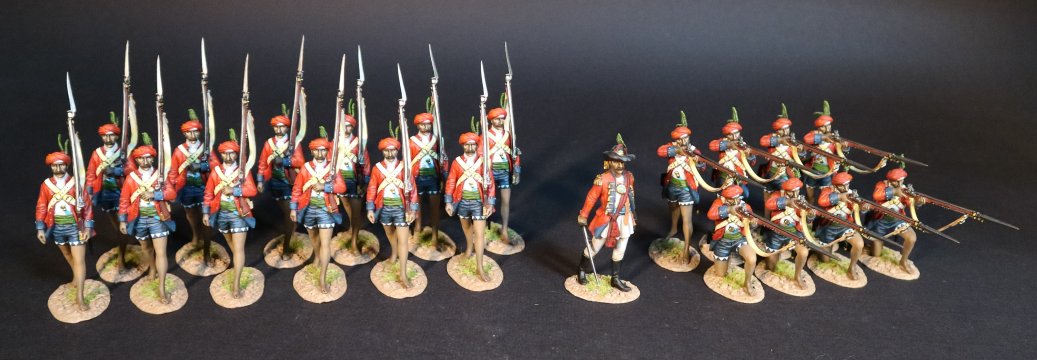
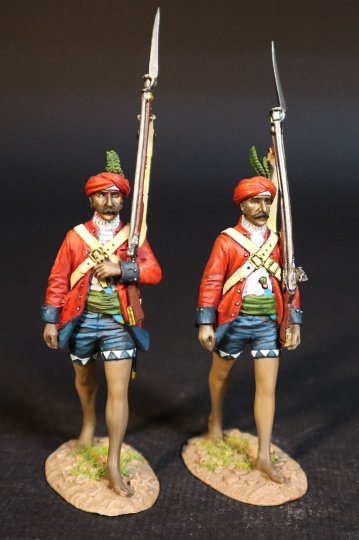
WBS-02
THE SEVEN YEARS WAR,
THE THIRD CARNATIC WAR 1756-1763,
THE BATTLE OF WANDEWASH, 22[SUP]nd[/SUP] JANUARY 1760,
THE BRITISH ARMY,
BRITISH SEPOYS
At the outset native units were in effect mercenary bands, recruited, equipped and led by their own officers, and generally referred to as Peons. By 1750 the East India Company were training and equipping their native soldiers in European fashion, and distinguishing them from the earlier rabble by using the term Sepoys instead.
In Bengal the first permanent unit of Sepoys was formed by Clive in early 1757. Clive dressed the Bengal Sepoys in red which was also adopted by the Madras units in 1759.
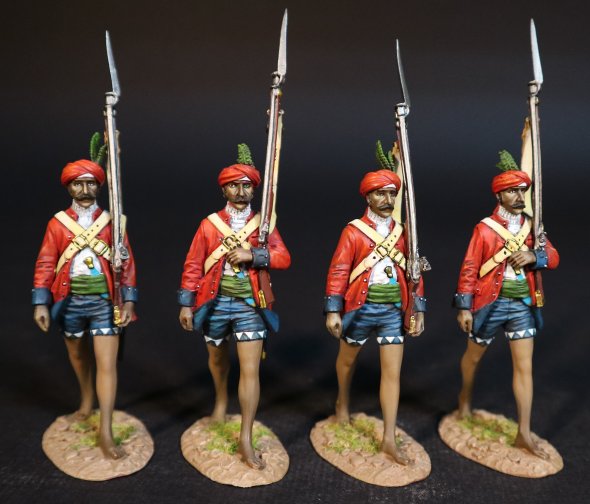
WBS-02N
THE SEVEN YEARS WAR,
THE THIRD CARNATIC WAR 1756-1763,
THE BATTLE OF WANDEWASH, 22[SUP]nd[/SUP] JANUARY 1760,
THE BRITISH ARMY,
BRITISH SEPOYS.
** PLEASE CONTACT YOUR LOCAL DEALER FOR FURTHER INFORMATION **
THE EIGHTEENTH CENTURY COLLECTION
THE AMERICAN WAR OF INDEPENDENCE 1775 – 1783
THE BATTLE OF COWPENS, JANUARY 17[SUP]th[/SUP], 1781.
THE 7[SUP]th[/SUP] REGIMENT OF FOOT (ROYAL FUSILIERS.)
The Battle of Cowpens was an engagement during the American Revolutionary War fought on January 17[SUP]th[/SUP] 1781, near the town of Cowpens, South Carolina, between American forces under Brigadier General Daniel Morgan, and British forces under Lieutenant Colonel Banastre Tarleton, as part of the campaign in the Carolinas.
The battle was a turning point in the American reconquest of South Carolina from the British.
Tarleton’s force of 1,000 British troops were set against 2,000 troops under Morgan. Morgan’s forces suffered casualties of only 25 killed and 124 wounded. Tarleton’s force was almost completely eliminated with almost 30% casualties and 55% of his force captured or missing, with Tarleton himself and only about 200 British troops escaping.
Morgan’s forces conducted a double envelopment of the British forces, the only double envelopment of the war.

The Royal Fusiliers (city of London Regiment) was a line infantry regiment of the British Army which has been in continuous existence for 283 years. It was known as the 7[SUP]th[/SUP] Regiment of Foot until the Childers Reforms in 1881.
In 1747 the regiment was known as the Royal English Fuziliers and was given the precedence of 7[SUP]th[/SUP] in the Infantry of the Line. On 1[SUP]st[/SUP] July 1751 it was redesignated as the 7[SUP]th[/SUP] Regiment of Foot (Royal Fusiliers).
When county titles were added in August 1782 the subtitle (Derbyshire) was added, but this was never used and was later given to a different regiment.
The Royal Fusiliers were sent to Canada in April 1773. The regiment was broken up into detachments that served at Montreal, Quebec, Fort Chambly and Fort St. Johns. In the face of the American invasion of Canada in 1775/76, the 80 man garrison of Fort Chambly attempted to resist a 400 man Rebel force but ultimately had to surrender, losing its regimental colors as a result. The bulk of the regiment was captured when St. John’s fell.
A 70 man detachment under the command of Captain Humphrey Owens assisted with the Battle of Quebec in December 1775.
The men taken prisoner during the defense of Canada were exchanged in British held New York city in December 1776. Here the regiment was rebuilt and garrisoned New York and New Jersey. In October 1777, the 7[SUP]th[/SUP] participated in the successful assaults on Fort Clinton and Fort Montgomery and the destruction of enemy stores at Continental Village. In late November, 1777 the regiment reinforced the garrison of Philadelphia. During the British evacuation back to New York city, the regiment participated in a diversionary raid in the days leading up to the Battle of Monmouth in June 1778.
In April 1780, the Royal Fusiliers took part in the capture of Charleston. Once Charleston fell, the regiment helped garrison the city. Three companies were sent to Ninety-Six to assist with the training of Loyalist militia companies. An 80 man detachment was also sent to Camden, South Carolina to help build that town’s defenses. The detachments were recalled to Charleston for refitting in late August 1780.
The 7[SUP]th[/SUP], mounted on horses, along with the two regiments of Loyalist militia, cleared the region north of Georgetown, South Carolina of partisans while en route. The Royal Fusiliers turned the horses over to Lieutenant Colonel Banastre Tarleton’s British Legion upon uniting with Cornwallis in late September and then served as the Army’s rearguard.

CW7FL-01
THE AMERICAN WAR OF INDEPENDENCE 1775-1783,
THE BATTLE OF COWPENS, JANUARY 17[SUP]th[/SUP] 1781,
7[SUP]th[/SUP] REGIMENT OF FOOT (ROYAL FUSILIERS)
OFFICER AND DRUMMER
THE BRITISH LEGION
The British Legion was a British provincial regiment established during the American Revolutionary War, composed of British loyalist American infantry and dragoons. It was known as Tarleton’s Raiders after the British officer who led most of its day to day activities, Lieutenant Colonel Banastre Tarleton, and the green uniform coats. It was an unit the size of a regiment consisting of infantry, cavalry, and artillery, and able to operate independently.

CWBL-08
THE AMERICAN WAR OF INDEPENDENCE 1775 – 1783
THE BATTLE OF COWPENS, JANUARY 17[SUP]th[/SUP], 1781.
THE BRITISH LEGION – “TARLETON’S RAIDERS”,
BRITISH LEGION INFANTRY

CWBL-08N
THE AMERICAN WAR OF INDEPENDENCE 1775 – 1783
THE BATTLE OF COWPENS, JANUARY 17[SUP]th[/SUP], 1781.
THE BRITISH LEGION – “TARLETON’S RAIDERS”,
BRITISH LEGION INFANTRY
THE QUEEN’S RANGERS (1[SUP]st[/SUP] AMERICAN REGIMENT) 1778-1783
SIMCOE’S RANGERS
The Queen’s Rangers came into being when Robert Rogers was authorized to raise a “Corps of Provincials” on August 16[SUP]th[/SUP] 1776. Recruited originally from Loyalists in New York and Connecticut, its men were farmers and city dwellers with little military experience.
They were a Loyalist military unit and were named for Queen Charlotte, consort of George III. The Queen’s Rangers served as a light corps in the tradition of British Rangers during the war, operating on the flanks and in advance of Crown forces, manning outposts, conducting patrols, and carrying out reconnaissance and raiding operations.


SQR-14
THE AMERICAN WAR OF INDEPENDENCE 1775 – 1783
THE BRITISH ARMY,
THE QUEEN’S RANGERS 1778-1783,
SIMCOE’S RANGERS,
LIGHT INFANTRY OFFICER
Simcoe had advanced ideas regarding training and discipline. He advocated constant vigilance, physical activity, and endurance of fatigue. There was constant instruction in marksmanship, the use of the bayonet, open formations, and the use of ambuscades. Units were trained to seldom return by their outgoing route. Officers were selected on their ability to perform such duties, and promotions when they occurred were from within the corps.
Regularity of messing and cleanliness were stressed, and officers were held responsible for the health of their men.
Written orders were avoided when possible, officers met after parade and received their orders verbally.
After the war, the Rangers were removed to the British colony of Nova Scotia and disbanded.
THE SEVEN YEARS WAR
THE THIRD CARNATIC WAR 1756-1763
THE BATTLE OF WANDEWASH, 22[SUP]nd[/SUP] JANUARY 1760
THE BRITISH ARMY
The Battle of Wandewash was a confrontation between the French under the command of The Comte de Lally, and the British Sir Eyre Coote. It was the decisive battle in the Anglo French struggle in southern India during the Seven Years War.
Lally, cut off from sea support by the withdrawal of Admiral d’Aché’s fleet and hampered by a lack of funds and by dissensions among his troops, tried to recover the fort of Wandiwash near Pondicherry.
There he was attacked and routed by Coote, with about 1,700 British troops against about 2,000 French. Lally’s best general, the marquis de Bussy, was captured. The French were thereafter confined to Pondicherry, which surrendered on Jan. 16, 1761, after much privation. Lally was later imprisoned and executed, after a trial in Paris, for alleged treason
The following two British regular units served in India and were present at the battle of Wandewash. It should be noted however that it was rare for these units to serve as complete battalions, and that they were generally broken up into detachments.
The British 79[SUP]th[/SUP] Regiment of Foot, was raised in November 1757, originally as the 64[SUP]th[/SUP] with drafts taken from the 4[SUP]th[/SUP], 8[SUP]th[/SUP] and 24[SUP]th[/SUP] foot, but was later re-numbered during the shake up after various second Battalions were taken into the line.
The regiment was to mainly see service in India from 1758, and was disbanded in 1764.
Its commander was Major Brereton
The 84[SUP]th[/SUP] (Coote’s) Regiment was raised in January 1759, specifically for service in India.
The regiment was ordered home to be disbanded in 1764, but was instead reduced in India and most of the personnel were to enter the East India Company service.
Initially the Madras European Regiment were not conventionally organized infantry battalions. Their organization, or what there was of it, resembled that of the marines, serving in effect as a pool from which more or less ad hoc companies and detachments could be formed for specific tasks. As long as the East India Company’s need was for purely defensive forces, tasked with watching over its factories and escorting merchants and officials this informal organization was adequate.
BRITISH SEPOYS


WBS-02
THE SEVEN YEARS WAR,
THE THIRD CARNATIC WAR 1756-1763,
THE BATTLE OF WANDEWASH, 22[SUP]nd[/SUP] JANUARY 1760,
THE BRITISH ARMY,
BRITISH SEPOYS
At the outset native units were in effect mercenary bands, recruited, equipped and led by their own officers, and generally referred to as Peons. By 1750 the East India Company were training and equipping their native soldiers in European fashion, and distinguishing them from the earlier rabble by using the term Sepoys instead.
In Bengal the first permanent unit of Sepoys was formed by Clive in early 1757. Clive dressed the Bengal Sepoys in red which was also adopted by the Madras units in 1759.

WBS-02N
THE SEVEN YEARS WAR,
THE THIRD CARNATIC WAR 1756-1763,
THE BATTLE OF WANDEWASH, 22[SUP]nd[/SUP] JANUARY 1760,
THE BRITISH ARMY,
BRITISH SEPOYS.
** PLEASE CONTACT YOUR LOCAL DEALER FOR FURTHER INFORMATION **

